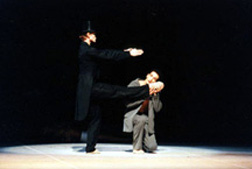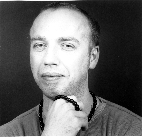Hamburg
Ballet:
John Neumeier's Nijinsky
Nijinsky—Lost in the Chaos
Nijinsky
Hamburg Ballet
Opera House, John F. Kennedy Center for the Performing Arts
February 25, 2004
Clare
Croft
copyright © 2004 by Clare Croft
published 26 February 2004
 Vaslav
Nijinsky is a ballet icon. His ballets and life story have cemented his
place in dance history. But with iconic status sometimes comes a flattening
of character, and John Neumeier’s depiction of the famous dancer
in the evening length Nijinsky has fallen into this trap. Neumeier
devotes most of his two-and-half-hour ballet to placing Nijinsky’s
inner landscape onstage, creating a swirl of impossible-to-digest dance
that presents Nijinsky as a one-dimensional figure, lost in the swirl.
The man who created the first truly modern ballets and passed through
two complicated relationships, first with impresario Serge Diaghilev,
then later his wife Romola, appears the same throughout Neumeier’s
ballet. Though the relationships were, in fact, very different, Neumeier's
depictions are not. The
lack of subtle character development was even more striking after having
seen Norman Allen's "Nijsinky's Last Dance" at the Kennedy Center
this past fall.
Vaslav
Nijinsky is a ballet icon. His ballets and life story have cemented his
place in dance history. But with iconic status sometimes comes a flattening
of character, and John Neumeier’s depiction of the famous dancer
in the evening length Nijinsky has fallen into this trap. Neumeier
devotes most of his two-and-half-hour ballet to placing Nijinsky’s
inner landscape onstage, creating a swirl of impossible-to-digest dance
that presents Nijinsky as a one-dimensional figure, lost in the swirl.
The man who created the first truly modern ballets and passed through
two complicated relationships, first with impresario Serge Diaghilev,
then later his wife Romola, appears the same throughout Neumeier’s
ballet. Though the relationships were, in fact, very different, Neumeier's
depictions are not. The
lack of subtle character development was even more striking after having
seen Norman Allen's "Nijsinky's Last Dance" at the Kennedy Center
this past fall.
read review
Nijinsky: Madness and Metaphor
Nijinsky
Hamburg Ballet
Opera House, John F. Kennedy Center for the Performing Arts
Washington, D.C.
February 26 and February 28 (evening), 2004
by
Alexandra Tomalonis
copyright © 2004 by Alexandra Tomalonis
published 1 March 2004
 It’s
not often one gets to see identical twins take on a leading role. John
Neumeier provided just such an opportunity by casting Jirí and
Otto Bubenícek as Nijinsky in his evening-length work of that name.
In this case, curiosity was well-rewarded: there were not only differences,
but each man had contrasting strengths. (I must state that my comparison
is from viewing the two only in this one role in this season, and that
I’m trusting that each twin danced at his announced performance.
The two also alternated as Nijinsky in the Faun, each playing Faun to
his brother's Nijinsky.) J. Bubenícek, who danced the role
opening night, has a stronger technique; O. Bubenícek’s,
at the Saturday evening performance, danced with more plasticity and more
expression.
It’s
not often one gets to see identical twins take on a leading role. John
Neumeier provided just such an opportunity by casting Jirí and
Otto Bubenícek as Nijinsky in his evening-length work of that name.
In this case, curiosity was well-rewarded: there were not only differences,
but each man had contrasting strengths. (I must state that my comparison
is from viewing the two only in this one role in this season, and that
I’m trusting that each twin danced at his announced performance.
The two also alternated as Nijinsky in the Faun, each playing Faun to
his brother's Nijinsky.) J. Bubenícek, who danced the role
opening night, has a stronger technique; O. Bubenícek’s,
at the Saturday evening performance, danced with more plasticity and more
expression.
read review
Nijinsky and the Ballets Russes
Nijinsky
Hamburg Ballet
Opera House, John F. Kennedy Center for the Performing Arts
Washington, D.C.
February 25 and February 28 (matinee), 2004
by
George Jackson
copyright © 2004 by George Jackson
published 1 March 2004
 The
conception is sweeping. Call it symphonic or cinematic, there is cohesive
movement at the core of John Neumeier's Nijinsky. It has an effect,
it makes a splash, Act 1 more so because it never stops. Transitions are
part of the continuum. Choreography, characterizations and narrative are
fused inextricably.
The
conception is sweeping. Call it symphonic or cinematic, there is cohesive
movement at the core of John Neumeier's Nijinsky. It has an effect,
it makes a splash, Act 1 more so because it never stops. Transitions are
part of the continuum. Choreography, characterizations and narrative are
fused inextricably.
The first act's story is simpler. It starts with the opening of Vaclav
Nijinsky's last public performance and goes back in time to the course
of his early life and his career—he was, of course, the new 20th
Century's god of the dance. In the second act, seams show. There were
pauses that had no apparent purpose, there were ebbs in the work's surging
tide. The real world at war intruded in an alien way, not fully fusing
with Nijinsky's extreme choreography, his madness and his brother's demented
state. And, more at one performance than another, the insanity of Nijinsky's
last dance was an anticlimax after the brother's explosion.
read
review
Batsheva: Breaking Down Walls
Deca
Dance
Batsheva Dance Company
America Dancing, Kennedy Center
Eisenhower Theater
Washington, D.C.
Feb. 26-27, 2004
by
Lisa Traiger
copyright 2004 by Lisa Traiger
published 1 March 2004
 Ohad
Naharin likes to line up his dancers across the front of the stage letting
them spout off tightly packed phrases of movement, sequentially or, to
increase the effect, all at once. This is how his Deca Dance
opens and the formation returns in different costumes with different movement
over the course of the evening. It's as if Naharin wants to break down
that invisible but necessary barrier between performer and audience. And
then he does.
Ohad
Naharin likes to line up his dancers across the front of the stage letting
them spout off tightly packed phrases of movement, sequentially or, to
increase the effect, all at once. This is how his Deca Dance
opens and the formation returns in different costumes with different movement
over the course of the evening. It's as if Naharin wants to break down
that invisible but necessary barrier between performer and audience. And
then he does.
read review
Dance with Texture—and a Heart
Ronald K. Brown/Evidence
Dance Place
Washington, D.C.
February 29, 2004
by
Clare Croft
copyright © 2004 by Clare Croft
published 1 March 2004
Ron Brown’s
choreography displays the best of a postmodern approach—diverse
fusion of movements --while still embracing the capital letter ideals
of Modernism, Truth and Beauty. Watching Brown’s company Evidence
in their Sunday night performance at Dance Place, particularly in “Come
Ye” a work that received its Washington premiere on Thursday at
George Mason University, I felt I was watching a choreographer borne of
the postmodern generation dismiss the relativist, flat-line tendencies
that make so much of today’s choreography look the same. In Come
Ye, a celebration of singer Nina Simone, Brown and his dancers (he
performed with the company) defer to something bigger and higher than
themselves. Repeatedly, they raise their arms, hands balled into fists,
and arch their chests upward, embracing the air and at times each other
with a reverent, almost sacred quality. But, this call to something beyond
the stage does not have the dated air of the twentieth century classics
because Brown’s seamless fusion of West African, modern and club
dance solidly ties the universal to contemporary everyday life.
read review
What's On This Week
March
3-7
New York City Ballet
Some readers weren't born the last time New York City Ballet danced here.
The company makes a welcome return.
From the Kennedy Center's website: Co-founded by the 20th century’s
foremost choreographer, George Balanchine, the legendary New York City
Ballet is one of the most highly esteemed classical ballet companies in
the world. As part of its yearlong tribute to the centennial of Balanchine’s
birth, NYCB is making a triumphant return to the Kennedy Center after
a 17-year absence.
During the weeklong appearance, New York City Ballet will perform seven
of Balanchine’s most enduring masterpieces. The repertory will include
Apollo (1928), the oldest Balanchine work in NYCB’s repertory;
Prodigal Son (1929), his powerful depiction of the biblical parable;
Serenade (1934), the first ballet Balanchine choreographed after
arriving in the United States; the dazzling Concerto Barocco (1941),
set to Bach’s Concerto in D minor for Two Violins; Symphony
in C (1947), one of his most beloved works; Tschaikovsky Piano
Concerto No. 2 (1941), a ballet that demands virtuosity from its
dancers; and Jewels (1967), Balanchine’s three-act abstract
ballet.
Opera House, 7:30 p.m.
www.kennedy-center.org
March
2, 2004
Take Five: Tehreema Mitha Dance Company
Tehreema Mitha and company showcase their unique style of dance, as they
blend contemporary styles with the classical Indian dance form known as
Bharatanatyam. While incorporating the universal themes of love and lore,
they bring a radically modern approach to traditional issues. 5:30
Clarice Smith Kogod Studio Theatre
Robert and Arlene Kogod Studio Theatre
Clarice Smith Performing Arts Center
University of Maryland is easy to visit.
Route 193 (University Blvd.) and Stadium Drive
301-405-ARTS
March
5-7, 2004
Edgeworks Dance Theater
EDGEWORKS Dance Theater premieres "Extreme Measures," a dynamic
performance featuring premieres by internationally-renowned guest choreographers
Earl Mosley (NYC), Robert Moses (San Francisco, CA) and Kevin Wynn (NYC).
The artists’ works are derived not only from personal experiences
and conversations on masculinity, but also from current social issues.
Friday and Saturday at 8, Sunday at 4.
DancePlace
3225 8th St. NE
Washikngton, DC
202-269-1600
March
5-7
George Washington University
Three evenings of student dance highlight the weekend at the George Washington
University. Senior dance thesis students present their choreography projects
in “Accumulating Forms” on Thursday and Friday. Saturday’s
performance is the annual Student Performance Art and Dance Event.
8 p.m.
Dorothy Betts Theater – Marvin Center
800 21st St., NW
202-994-7470
March
6-7
Debut
An evening of new works by three of DC’s newest up-and-coming
choreographers. District Dance Project (DDP) is a new organization whose
mission is to help produce and promote new, local choreographic talent.
DDP’s first production will present the work of choreographers Jennifer
Dorsey, Connie L. Fink and Ruben Graciani. Saturday at 8, Sunday at 7.
Jack Guidone Theater
Joy of Motion Dance Center
5207 Wisconsin Ave., N.W.
Washington, D.C. 20015
(202) 362-3042
March
6-7, 2004
Bowen McCauley Dance Company
Both programs offer a world premiere collaboration with the Arlington-based
early music ensemble HESPERUS performing Appalachian ³crossover²
music titled For No Good Reason at All. This will be the second collaboration
for Bowen McCauley and the duo of HESPERUS and Bruce Hutton. Saturday
evening also includes a performance by three-time world exhibition dance
champions and Arlington residents Sharon and David Savoy. Saturday at
7:30 p.m., Sunday at 2:00 p.m.
Gunston Theatre One
2700 S. Lang St.,
Arlington, Virginia
703.955.0382
An Acrobatic Showcase
Choreographers
Showcase
[produced
by the Maryland National Park and Planning Commission]
Dance Theatre
Clarice Smith Performing Arts Center
University of Maryland
February 28, 2004
by
Tehreema Mitha
copyright 2004 by Tehreema Mitha
published 1 March 2004

read review
Zoltan Nagy
C.
Voltaire
Making Dances / Taking Chances Series
Robert & Arlene Kogod Theatre
Clarice Smith Performing Arts Center
The University of Maryland
College Park, Maryland
Saturday, February 28, 2004
by George Jackson
copyright 2004
by George Jackson
published 1 March 2004

read review
|
|
|